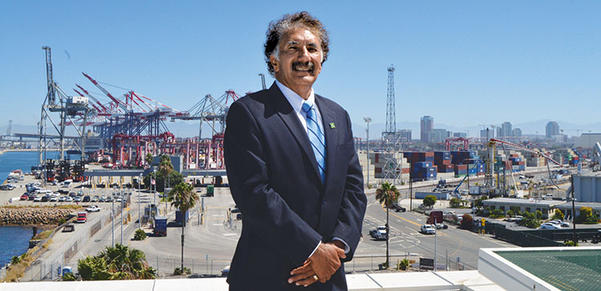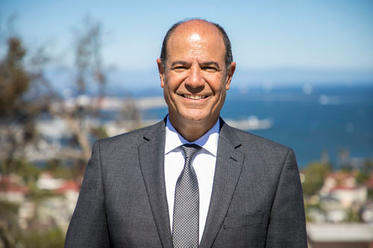A fog of uncertainty surrounding the outlook for international trade through the San Pedro Bay ports has cleared now that the new alliance structures among major shipping companies are two months into operation and, according to port officials, have rolled out smoothly.
In advance of four alliances among the world’s largest shipping companies consolidating into three alliances, which occurred in April, trade experts wondered if there would be changes in which ships called which local port and if there would be any confusion.
Subsequently, both ports experienced the busiest May in their histories – and the outlook remains positive.

Former Federal Maritime Commission Chair and Long Beach Harbor Commissioner Mario Cordero recently took over as executive director of the Port of Long Beach. Cordero indicated he is focused on ensuring that the port’s reputation as a service-oriented operation continues to be known throughout the trade industry. (Photograph by the Business Journal’s Larry Duncan)
The combined ports of Long Beach and Los Angeles could achieve an all-time high for imported cargo traffic this year, according to John Husing, chief economist for the Inland Empire Economic Partnership. “I think that this year the import side will set an all-time record. The previous high was 8.2 million TEUs in 2006,” he said, referring to twenty-foot equivalent units. “It has taken a long time to recover, but in 2017, it looks like it’s going to come in somewhere around 8.4 or 8.5 million [TEUs].”
Mario Cordero, the newly-minted executive director of the Port of Long Beach (POLB), said POLB should experience between 4% and 5% import growth by the end of 2017.
Michael DiBernardo, deputy executive director of marketing and customer relations for the Port of Los Angeles (POLA), said he expects to finish the calendar year with a 2.8% gain in imports.
Export traffic, on the other hand, is still stymied by the pressure of a strong American dollar, which makes U.S. goods more expensive abroad. One euro is currently worth about $1.12 in American money, according to Husing. “[The dollar] has weakened a little bit. I just got back from Europe, and a month ago it was $1.05 per euro. . . . But still, it’s quite strong, and that strength tends to encourage imports and discourage exports.”
Despite that, Husing said he expects exported containerized cargo traffic through the ports of Long Beach and Los Angeles to either meet or come close to their record export volume of 3.6 million TEUs.
“Exports, of course, are always challenging,” Cordero said. “They are challenging across the nation. . . . But having said all that, I think the good news looking forward is this nation is going to be on a full-court press with regard to selling and exporting American product. And we’re going to find ways to do that.”
Although cargo volumes at both ports are increasing, Husing said they appear to be losing their market share in respect to other ports in the country. An oft-cited statistic is that 40% of the nation’s goods move through the San Pedro Bay Ports – but that share has dropped to 38%, according to the economist.
The expansion of the Panama Canal, which added a third, deeper lock for ships, has resulted in some loss of traffic to East Coast ports, according to Husing. Additionally, the San Pedro Bay ports have lost some of their market share to other West Coast ports. The increasing role of India, which ships through Egypt’s Suez Canal to America, as an exporter to the U.S. has also resulted in some loss of market share, he explained.
DiBernardo said the Port of Los Angeles is keeping an eye on the Port Authority of New York & New Jersey, which recently raised its Bayonne Bridge to allow larger ships to cross beneath it. The Port of Long Beach, it should be noted, is in the midst of a similar undertaking by demolishing its Gerald Desmond Bridge and replacing it with a taller structure.
While Husing thinks the ports of Long Beach and Los Angeles are doing well and will continue to experience increasing cargo volumes, he speculated that their market share would continue to diminish. Factors such as traffic congestion and a court’s decision to kill BNSF Railway’s Southern California International Gateway project, which could have alleviated some of that congestion by expanding the area’s rail capacity, also contribute to this outlook, he explained.
Cordero, who served as a harbor commissioner at POLB from 2003 until 2010, when President Barack Obama appointed him to the Federal Maritime Commission, acknowledged that there has been a single-digit percentage loss in market share for the San Pedro Bay ports. But, he pointed out, when he was a commissioner, the worst-case scenario projection for the future was as much as a 25% loss.
“There has been some loss of the market share. . . . But on the other hand, it’s nowhere near the magnitude that people may have estimated some years ago,” Cordero said. Still, he is not content to simply protect POLB’s position – he wants to grow it. “I’m confident we can do that,” he said.
Capital Projects And Supply Chain Improvements
The Port of Long Beach is spending about $4 billion on two major capital improvement projects to achieve that end. The Middle Harbor Redevelopment Project, which involves combining two aging terminals to accommodate the world’s largest ships, is currently in phase two of three, according to Cordero. Long Beach Container Terminal, a division of Orient Overseas Carrier Line, has been operating the completed first phase since 2015. The terminal features zero-emission cranes and cargo moving equipment, as will its other facilities upon completion in 2019.
“Long Beach Container Terminal is a state of the art terminal in the United States and, for that matter, in the world,” Cordero said. “So we are starting to see the fruition of that in terms of the numbers. It’s sort of like the old cliché, you know: Build it and they will come. So we are starting to see that.”
The Gerald Desmond Bridge Replacement Project is visibly progressing, with two massive towers hovering high above the roadway of the existing bridge, as well as pillars and roadway approaches underway on either side of the structure. “Again, among the reasons we moved forward with that endeavor was to raise the height of that bridge so that it would accommodate these newer vessels,” Cordero said. The bridge should be completed in fall of next year, he noted.
“That bridge is going to be iconic, not just to Long Beach and this port but to the nation,” Cordero said.
A proposal to expand rail infrastructure at Pier B in the Port of Long Beach is one that Cordero considers important to boosting cargo movement efficiencies. The draft environmental impact report (EIR) for the project was released earlier in the year and is now closed for comments. There are multiple options proposed, including creating additional tracks to 9th Street or as far as 12th Street.
Added rail capacity would reduce truck congestion and pollution, according to Cordero. However, the draft EIR does point out that the project would have some negative effects related to air emissions.

Michael DiBernardo, deputy executive director of marketing and customer relations for the Port of Los Angeles, expects his port to experience increases in imports and exports this year. He noted that he is keeping an eye on improvements to ports on the East Coast that could pull some cargo away from the San Pedro Bay. (Photograph provided by the Port of Los Angeles)
As previously reported by the Business Journal, Westside Long Beach businesses are in the path of the project, and owners worry about being forced to close or relocate. Others nearby have voiced concerns about air quality impacts.
“We are certainly not dismissive of any stakeholder, much less the business community and the small business enterprises that are in that particular corridor,” Cordero said. “You know, no one is going to try to be dismissive and ignore their legitimate issues. So we are going to be very engaged with it.”
The Port of Los Angeles is wrapping up two terminal improvement projects in coming months. Yusen Terminals’ facility has had its wharf water levels deepened to accommodate larger vessels, and an on-dock rail project for the terminal should be complete in November, according to DiBernardo.
Improvements including extended wharves, increased water depths at berths and new cranes are nearly complete at the TraPac Terminal. Its new automated equipment is currently undergoing testing, DiBernardo noted.
POLA is currently reviewing comments on the environmental impact report for similar improvements to its Evergreen Terminal. “After we respond [to comments], we’re hoping to get it out for our board to review by October or November of this year,” DiBernardo said.
Both ports have been working together to improve the efficiency of the supply chain through a series of meetings with stakeholders sanctioned by the Federal Maritime Commission. In 2015, the chassis pool of pools, an interchangeable pick-up and drop-off system among several companies for the equipment used by trucks to haul containers, was one result. But Cordero hopes more solutions can be brought to fruition.
“In my view, we’re going to continue with the objectives of that endeavor. But I think now we’re at a point where we’re going to start narrowing the issues, because we need a deliverable,” Cordero said.
The Port of Los Angeles is engaged in a couple of pilot programs aimed at providing more information related to supply chain efficiencies. “We now have access to information that has GPS in trucks, and we’re able to get the total visit time that the trucks are at the port,” DiBernardo said. “That even includes outside the gate and in the terminal. And we have seen some improvements there with the turn times,” he explained.
POLA is also continuing its pilot program in partnership with GE to gather data from incoming ships to share among terminals and ensure better flow of goods upon arrival.
“Providing data 14 days before the ship arrives provides a benefit to the chassis providers to make sure there are enough chassis available for when the ship arrives, [and] for the rail providers to make sure there are enough rail cars,” DiBernardo said. “And even for the trucking community to make sure they have the truck power to move that cargo for their respective customers. We think this portal gives you that information, provides that information ahead of time.”
Environmental Efforts
After Long Beach Mayor Robert Garcia and Los Angeles Mayor Eric Garcetti made a joint announcement in early June committing to achieving zero-emission operations at their cities’ ports by 2035, the ports released a timeline for implementing the update to their Clean Air Action Plan, which will set the parameters to achieve this goal.
The draft of the updated plan is set to be released on July 19, commencing the public commenting period. On August 30, a public workshop to collect comments will be held at 5 p.m. at Banning’s Landing, 100 E. Water St., Wilmington.
The written comment period closes on September 18. In November, the Long Beach and Los Angeles harbor commissioners plan to hold a joint meeting to approve the final version of the Clean Air Action Plan 2017.
Meanwhile, the Port of Los Angeles is also in the midst of another effort meant to assess air quality. The port has released a draft EIR that updates a 2008 report related to the construction and operation of the China Shipping Container Terminal. The new EIR analyzes potential new environmental impacts and effects to air quality, greenhouse gases and other issues that could result from incrementally increasing cargo traffic through that terminal. The public comment period on that document ends on July 31. To download the document and review public meeting dates and more, visit www.portoflosangeles.org/EIR/ChinaShipping/DSEIR/dseir_china_shipping.asp.
